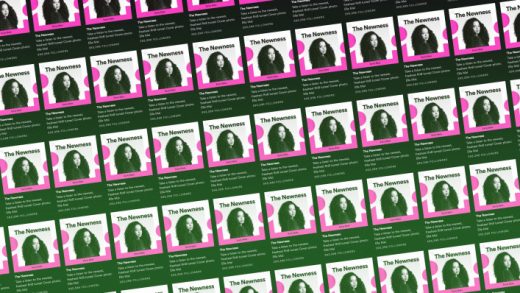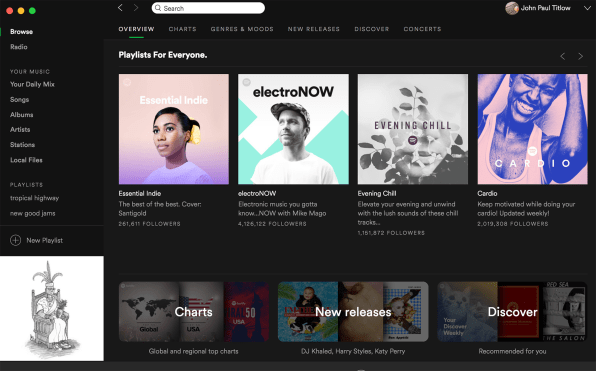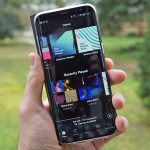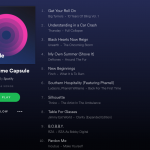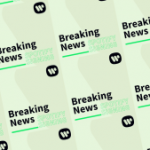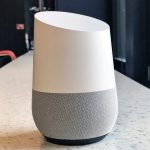Five Steps To Becoming a Successful Artist on Spotify
From the look of things, streaming is shaping up to be the savior that the music industry has been clamoring for since the early 2000s. But is it really?
Streaming services now contribute over 50% of industry revenue worldwide, according to a recent industry report by the International Federation of the Phonographic Industry. Over the last two years, the recorded music industry has grown for the first time since its Napster-induced decimation over 15 years ago. Last year, it grew at its highest rate since 1997: 5.9% to $15.7 billion.
But when we refer to “the music industry,” we’re typically talking about the traditional industry—music rights holders and record labels, primarily. What about the artists? The fate of musicians and songwriters themselves remains an entirely different question with a much more complicated answer. The per-stream royalty rates of streaming are still tiny, but as services like Spotify and Apple Music scale, the numbers do start to look better for some artists.
Still, it’s not enough.
To help buoy musicians’ careers—and in turn make itself a more valuable resource to the industry—Spotify has been building out its artist-facing tools and teams, using everything from data analytics and targeted concert ticket sales to playlist placement to serve artists and assuage their anxieties about the future. It’s still early—Spotify for Artists, its analytics dashboard, just came out of beta a few weeks ago—so it’s not always clear to artists how to make the most of this new all-you-can-stream ecosystem. Here’s a primer.
Step One: Get Your Music Onto The Platform
It may seem obvious, but artists can’t reap the benefits of the streaming explosion without showing up in the first place. Unlike SoundCloud, YouTube, and Bandcamp, subscription services like Spotify don’t let you hit an “upload” button and share tracks for free. In most cases, the artist’s record label handles distribution, but for independent, unsigned acts, a third-party service like TuneCore, CDBaby or DistroKid will be required to get songs and albums onto Spotify (as well as Apple Music, Deezer, Tidal, and a long list of other streaming services).
TuneCore and CDBaby both charge $50 per album (TuneCore is $30 for the first year), but TuneCore charges an annual renewal fee. DistroKid starts at $20 per year for unlimited uploads, so that’s probably the best route to go for newer, unproven artists. Each of these services has their own perks and service tiers, so it’s worth reading up on each of their pricing models before committing. From there, it’s as simple as uploading lossless, high-quality audio files (an MP3 won’t cut it), album art, and some simple meta data to publish each release across the internet’s various digital music services and stores.
Of course, Spotify and other music services contain a massive sea of tens of millions of tracks and hitting the upload button simply adds another droplet to that ocean. Getting your music heard requires a bit more work.
Step Two: Get Your Music Everywhere Else, Too
Spotify may be the biggest music streaming service, but that doesn’t mean it’s the only place to focus on. Many experts agree that the key to getting heard these days is to spread one’s music as far and wide as possible. That includes free services like SoundCloud and YouTube (which are easily embedded by music writers, should you be so fortunate). But it also includes having a meaningful social presence on platforms like Facebook and Instagram, releasing music videos, considering licensing music for TV and games (“sync” in industry parlance) and, above all else, regularly playing live in the real world.
The internet may open up new doors to exposure and help level the playing field for musicians, but nothing can replace the value (and admittedly hard work) of lugging gear around and making an in-person, musical connection with actual people with actual ears. The more places one can reasonably and appropriately get their music playing, both online and off, the more potential opportunities they’ll have with the people most likely to give a damn.
Step Three: Get On The Radar Of Influential Music Bloggers And Journalists
One of the least cool and interesting parts of being a musician is promoting oneself, especially via the press. After all, people get into music to be artistically expressive, not to become publicists (which would undoubtedly be a more lucrative and stable career path). But one of the most important pieces of the online discovery puzzle is getting on the radar of influential music bloggers and journalists.
Most new artists aren’t going to land a write-up in Pitchfork or Rolling Stone right away, but fortunately there are a ton of smaller music publications, many of which focus on specific genres. Sites like Hype Machine aggregate some of the more influential music blogs and break them down by genre, so that’s a good place to get familiar with the most relevant music blogs. Local media like alt-weekly newspapers and city-specific music blogs might be easier nuts to crack than far-flung sites run by faceless editors with overflowing inboxes.
Cold-pitching strangers imploring them to check out your new EP is, again, decidedly unsexy and a little soul-sucking. The line between effective and obnoxious can be thin here. For those with the budget, hiring a professional to help with press outreach can be well worth it. For the cash-poor DIY artist, a crash course in media relations might be necessary. Of course, the easiest way to get media attention, many would argue, is to simply do cool, creative things that warrant attention. Just be mindful of the extraordinary level of noise with which you’re competing—and the extra creativity sometimes required to cut through it.
Why is this so important? Obviously media coverage means more exposure, as it always has. But today, getting a write-up and a song embed in the right place can act as a funnel into all kinds of other things. For one thing, writers at bigger publications mine these music blogs for the next big thing. So do music curators everywhere, like the people who program music for Starbucks. And yes, Spotify’s own in-house curators use music blogs (along with a variety of other signals, like catching a performer live) to find songs to include on Spotify’s playlists, which often have massive audiences.
Spotify’s semi-automated Fresh Finds playlist selects tracks by sniffing out online buzz from sources like music blogs. Songs that land on Fresh Finds are often heard by Spotify’s in-house music editors and can find their way onto other playlists. And if a track gets playlisted enough, it may become eligible for inclusion on Discover Weekly, Spotify’s hugely popular personalized virtual mixtape.
Step Four: Get Your Music Onto Playlists
Spotify reps are quick to stress that its in-house curation is a strictly “democratic” system, driven mostly by a combination of editorial intuition and data about how well songs are resonating with listeners. Spotify’s in-house curators do get tips and suggestions from labels and managers, but they say they don’t let those industry relationships trump editorial integrity and have strictly banned anything resembling pay-for-play on the platform. Thus, there’s no easy way to reliably pitch playlist curators. But there are ways to get onto their radar.
The simplest way for artists to get their songs onto Spotify playlists is, of course, to start building their own playlists. This is just a good idea in terms of building an audience on Spotify anyway. Well-constructed, searchable playlists are an easy path from the Spotify search box to an artist’s profile. A playlist of favorite songs by one’s biggest influences is a logical place to start and, while it might feel tacky to some, including a track or two from your own catalog alongside similar-sounding music isn’t a dishonest thing to do.
The more actively an artist curates and promotes their own playlists (with or without their own music), the more engaged they’ll be with listeners, and the greater the odds of their stuff coming across the radar of other playlisters—be it from a prominent Spotify user with lots of followers or one of the company’s in-house music programmers. By including one’s own music on a self-made mix, artists can effectively “seed” their songs in the playlist ecosystem in the hopes of getting it picked up by somebody else.
This process is decidedly difficult to influence or control directly, much like the process of getting press attention in the hopes of being picked up by Fresh Finds. Both approaches require a bit of finger-crossing and patience. While Spotify’s in-house curators are technically anonymous, it’s possible to google around to find the names and contact info of the people heading up different genres. Spotify doesn’t explicitly endorse this practice, but if you can manage to get the attention of its on-staff music nerds, it’s worth a shot.
An easier, though still clunky, approach would be to reach out to lower-level playlisters on the platform. This includes regular users who have heavily followed playlists and brands who manage their own playlists. Again, the odds of this tactic actually working will depend on the whim and tastes of the curators, but a quick search of like-minded playlists on Spotify and a hunt for their contact info may be well worth the effort.
Step Five: Dig Into Data With Spotify For Artists
Last month, Spotify opened up Spotify for Artists, a listener analytics dashboard, to all artists. This panel breaks down things like demographic info, where listeners live, how many listeners an artist has, and which playlists are driving new listeners. These numbers obviously won’t be huge for newer artists, but it’s useful to keep an eye on these metrics. Is your audience growing? Did a Spotify playlist give you a spike in new listeners? Which playlist? Maybe there’s a huge surge in streaming coming from Norway. What’s up with that?
Spotify’s analytics have been used by artists big and small to help inform decisions like how to plan their tours and which songs to include on their live set list. Keeping an eye on this dashboard will give musicians an up-to-date picture of what their audience looks like on Spotify.
As part of the launch of Spotify for Artists, the company simplified the process by which artists can get their profiles verified on the platform. Rather than having to reach 250 followers (a metric that is, somewhat confusingly, totally different from listeners or fans) in order to get verified, bands now merely need to sign up for access to Spotify for Artists and their profiles will automatically be verified once they’re approved. Verified artists are able to update their band photo and header graphic, publish playlists to their artist profile, select an “artist’s pick” song or playlist, and, presumably, customize whatever future artist-facing tools Spotify has in the works.
Spotify has been building out its resources to help musicians who are uncertain about streaming find more success. How to use them to your advantage.
From the look of things, streaming is shaping up to be the savior that the music industry has been clamoring for since the early 2000s. But is it really?
Fast Company , Read Full Story
(120)

